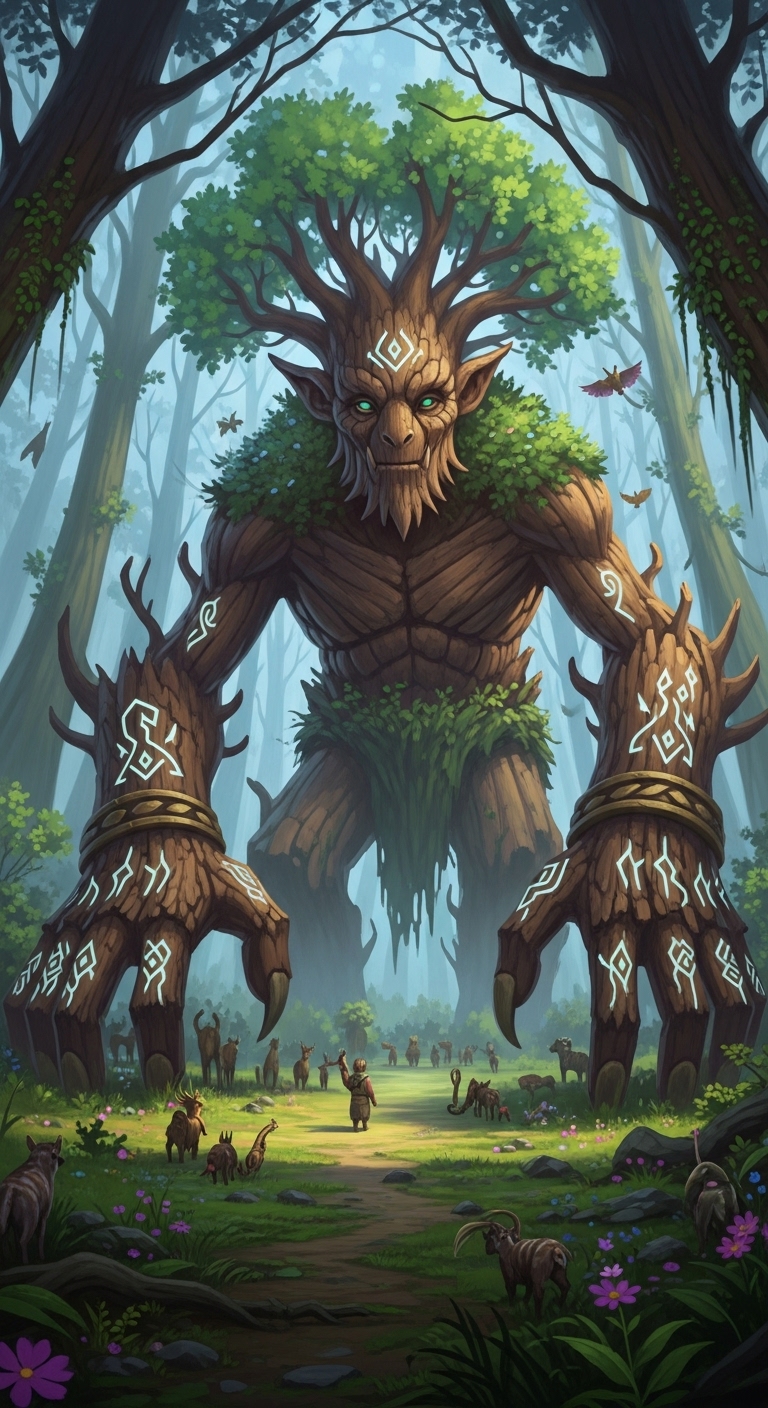Treant

- Size: Huge
- Type: Plant
- Alignment: Chaotic Good
- AC: 16
- Initiative: +3 (13)
- HP: 138 (12d12 + 60)
- Speed: 30 ft.
| ATTR | VAL | MOD | SAVE |
|---|---|---|---|
| STR | 23 | +6 | +6 |
| DEX | 8 | -1 | -1 |
| CON | 21 | +5 | +5 |
| INT | 12 | +1 | +1 |
| WIS | 16 | +3 | +3 |
| CHA | 12 | +1 | +1 |
- Skills: None listed
- Vulnerabilities: Fire
- Resistances: Bludgeoning, Piercing
- Senses: Passive Perception 13
- Languages: Common, Druidic, Elvish, Sylvan
- CR: 9 (XP 5,000; PB +4)
Traits
Siege Monster. The treant deals double damage to objects and structures.
Actions
Multiattack. The treant makes two Slam attacks.
Slam. Melee Attack Roll: +10, reach 5 ft. Hit: 16 (3d6 + 6) Bludgeoning damage.
Hail of Bark. Ranged Attack Roll: +10, range 180 ft. Hit: 28 (4d10 + 6) Piercing damage.
Animate Trees (1/Day). The treant magically animates up to two trees it can see within 60 feet of itself. Each tree uses the Treant stat block, except it has Intelligence and Charisma scores of 1, it can't speak, and it lacks this action. The tree takes its turn immediately after the treant on the same Initiative count, and it obeys the treant. A tree remains animate for 1 day or until it dies, the treant dies, or it is more than 120 feet from the treant. The tree then takes root if possible.
Lore & Background
Treants are ancient guardians of the forest, manifesting as massive tree-like creatures with the wisdom of millennia and the power to command all plant life within their domain. These noble beings serve as shepherds of the woodland, protecting ancient groves and maintaining the delicate balance between civilization and nature. Their deep connection to the natural world grants them intimate knowledge of every plant, animal, and ecological process within their territory.
Living for thousands of years, treants develop profound patience and long-term perspective that allows them to guide forest ecosystems through cycles of growth, death, and renewal. They remember the forest's history across centuries, serving as living libraries of natural knowledge while acting as intermediaries between the natural world and other sentient beings. Each treant is unique, shaped by the particular forest they guard and the experiences they've accumulated over their incredibly long lives.
Combat Tactics
Treants prefer to avoid violence when possible, using their imposing presence and deep voices to intimidate threats away from their forest homes. When forced to fight, they leverage their tremendous size and strength along with their ability to animate and command trees to overwhelm enemies. Their bark-like skin provides excellent natural armor while their massive limbs can crush most opponents.
In battle, treants use their control over plant life to reshape the battlefield, causing trees to move and attack while roots emerge from the ground to entangle enemies. They coordinate with local wildlife and forest spirits, turning the entire ecosystem against invaders. Their reach and area attacks make them particularly effective against groups of smaller opponents.
Encounter Ideas
1. The Threatened Grove A treant's ancient grove faces destruction from expanding civilization, mining operations, or magical corruption. The party must mediate between the treant's need to protect the forest and the legitimate needs of humanoid communities that depend on forest resources.
2. The Forest Council A treant calls upon the party to represent humanoid interests in a council of forest guardians discussing threats to the natural world. The characters must navigate complex ecological politics while advocating for balanced solutions.
3. The Awakening Ritual A treant seeks to awaken new treants from ancient trees to help guard expanding wilderness areas. The party becomes involved when this process is threatened by those who would prevent the creation of new forest guardians.
4. The Memory Keeper A treant possesses crucial historical knowledge that could resolve current conflicts or prevent future disasters. The party must earn the ancient guardian's trust while learning about events that occurred centuries ago.
Environmental Effects
- Forest Awakening: The treant's presence causes all plant life to become more active and aware of their surroundings
- Ecological Harmony: Areas under treant protection experience optimal growth patterns and biodiversity
- Natural Barriers: The treant can cause rapid plant growth to create walls, bridges, or other useful structures
- Wildlife Cooperation: Animals in treant territory become more cooperative and willing to assist the guardian's goals
Treasure
- Ancient Seeds (500-2000 gp): Rare plant varieties that can only be obtained from treants who have preserved them for centuries
- Living Wood (1000-5000 gp): Specially treated wood that retains some of the treant's life force and magical properties
- Forest Lore (varies): Extensive knowledge about natural history, ecology, and the secrets of plant magic
- Druidic Artifacts (varies): Items created through cooperation between treants and druid circles over many years
- Nature's Blessings (varies): Magical benefits granted by treants to those who prove themselves friends of the forest
Plot Hooks
1. The Dying Forest A treant's forest is slowly dying due to a supernatural curse or environmental poisoning that resists normal healing. The party must discover the source of the blight while helping the treant save their ancient home.
2. The Urban Expansion A growing city threatens to encroach on a treant's territory, creating conflicts between development and conservation. The party must find creative solutions that meet both human needs and environmental protection.
3. The Lost Saplings Young treants have gone missing, possibly kidnapped for their magical properties or corrupted by evil influences. The ancient treant seeks the party's help in finding and rescuing their progeny.
4. The Climate Crisis Unnatural weather patterns threaten to disrupt seasonal cycles that the treant has maintained for millennia. The party must investigate the magical or technological causes while helping the treant adapt to changing conditions.